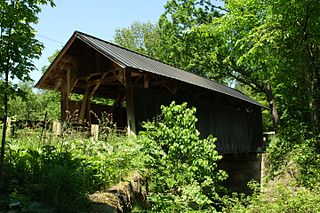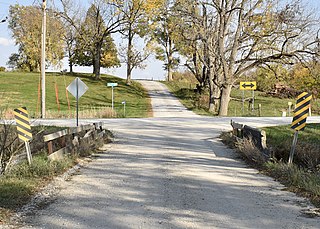
James Barney Marsh was an American engineer and bridge designer. He patented a new design for arch bridges. Marsh gave Archie Alexander, the first African-American to graduate as an engineer from Iowa State University, his first job. Marsh worked in the bridge building business for over 50 years, and several of his bridges are listed in the National Register of Historic Places.

The Lamar Boulevard Bridge is a historic arch bridge carrying Texas State Highway Loop 343 over Lady Bird Lake in downtown Austin, Texas, United States. The bridge features six open-spandrel concrete arches spanning 659 feet (201 m) and carries tens of thousands of vehicles daily across the lake. Completed in 1942, the Lamar Boulevard Bridge was the second permanent bridge to cross the Colorado River, and one of the last Art Deco-style open-spandrel concrete arch bridges built in Texas. The bridge was named an Austin Landmark in 1993 and added to the National Register of Historic Places in 1994.

The Cove Creek Bridge is a historic bridge, carrying Arkansas Highway 309 across Cove Creek, south of the hamlet of Corley, Arkansas in the Ozark-St. Francis National Forest. It is a two-span closed-spandrel masonry arch structure, with each span measuring 13 feet (4.0 m) and an overall structure length of 26 feet (7.9 m). It is built entirely out of stone, with a concrete and asphalt deck, and concrete barriers at the sides. It was built in 1936 with funding support from the Works Progress Administration.

Quinlan's Covered Bridge, also called the Lower Covered Bridge, and Sherman Covered Bridge is a wooden covered bridge that crosses Lewis Creek in Charlotte, Vermont on Monkton Road. It was listed on the National Register of Historic Places in 1974. It is one of nine 19th-century Burr arch covered bridges in the state.

The Yosemite Valley Bridges are eight bridges in the Yosemite Valley of Yosemite National Park, most of them spanning the Merced River. Five of them were built in 1928, with the remainder built between 1921 and 1933. The bridges feature a concrete structure faced with local stone, in an elliptical or three-centered arch configuration. They are notable for their uniform character and for their conformance to tenets of the National Park Service rustic style. Design work for the seven newer bridges was by George D. Whittle of the San Francisco District Office of the U.S. Bureau of Public Roads for the National Park Service. Concrete bridges were chosen at the urging of Thomas Chalmers Vint of the Park Service, in lieu of alternative designs for steel truss bridges, or suspension bridges suggested by the park superintendent.

The Seguin Covered Bridge, also called the Upper Covered Bridge and the Sequin Covered Bridge, is a wooden covered bridge that crosses Lewis Creek in Charlotte, Vermont on Roscoe Road. It was built about 1850, and is a distinctive variant of a Burr arch design. It was listed on the National Register of Historic Places in 1974.

The Calamus Creek Bridge near Maxwell, Iowa is a concrete Luten arch bridge constructed in 1905. It was built by N. M. Stark and Company for a cost of $900. It has a 25-foot (7.6 m) single span and a total length of 45 feet (14 m).
South Dakota Dept. of Transportation Bridge No. 49-095-190 is a historic bridge in rural Miner County, South Dakota. It carries a local road over Rock Creek, about 6 miles (9.7 km) south and 6.5 miles (10.5 km) west of Howard. Built in 1917, it is the longest pre-1920 concrete slab bridge in the state. Bridges from this time predate the standardization in the methods and use of concrete in bridge construction, and are relatively rare. The bridge consists of a single span 27 feet (8.2 m) in length, with a solid concrete parapet as a railing. The concrete is suffering from spalling.
The South Dakota Dept. of Transportation Bridge No. 30-257-400 is a historic bridge in rural Hand County, South Dakota. It is located 14 miles (23 km) south of Miller and 9.7 miles (15.6 km) east, and carries a local road over Sand Creek. The bridge is a single-span steel beam stringer bridge, resting on I-beam pile abutments with concrete wings. The bridge is 26 feet (7.9 m) long. Built in 1917, it was one of the first bridges built in the county by county employees, rather than by hired bridge companies, and predates the formation of state highway department by two years.

The Miller Creek Bridge is a historic bridge, carrying Miller Creek Road across Miller Creek, just north of the city limits of Batesville, Arkansas. Built in 1914, it is the state's oldest surviving concrete bridge. It is a two-span arched structure with a total length of 123 feet (37 m), and a width of 12 feet (3.7 m), carrying a single lane of traffic. The bridge is somewhat overengineered, as the use of concrete in bridge construction was then relatively new, and knowledge of the material's properties in this application was not well understood.

The Marble Bridge, formally known as the Fletcher D. Proctor Memorial Bridge, carries Main Street across Otter Creek in the center of Proctor, Vermont. Built in 1915, and widened in 1935-36, it is a well-preserved example of early concrete bridge construction, and is decoratively faced in local marble. The bridge was listed on the National Register of Historic Places in 1991.

The Quechee Gorge Bridge is a historic bridge, carrying U.S. Route 4 (US 4) across Quechee Gorge, near the Quechee village of Hartford, Vermont. Built in 1911, it is Vermont's oldest surviving steel arch bridge. It was listed on the National Register of Historic Places in 1990.

East Indian Creek Bridge is a historic structure located southeast of Nevada, Iowa, United States. It spans East Indian Creek for 78 feet (24 m). N.M. Stark and Company of Des Moines started building bridges for Story County beginning in 1902, and then they held an exclusive contract until 1913 when the Iowa Legislature banned the practice. Stark constructed this concrete Luten arch structure in 1912 for $4,462 as part of a multi-bridge contract. This was the longest concrete arch built by Stark in Story County. It was listed on the National Register of Historic Places in 1998.
The Centerville Township Bridge Number S-18 is a historic stone arch bridge on 294th Lane in rural Turner County, South Dakota, west of Centerville. Built in 1938, it is one of a modest number of surviving stone arch bridges built in the county with funding from New Deal jobs programs. It was listed on the National Register of Historic Places in 2000.
The Daneville Township Bridge No. E-26 is a historic stone arch bridge over an unnamed stream on 457th Avenue in rural Turner County, South Dakota, south of Viborg. Built in 1935, it is one of a modest number of bridges surviving in the county that was built with New Deal funding. It was listed on the National Register of Historic Places in 1999.

The West Sixth Street Bridge is a historic stone arch bridge in downtown Austin, Texas. Built in 1887, the bridge is one of the state's oldest masonry arch bridges. It is located at the site of the first bridge in Austin, carrying Sixth Street across Shoal Creek to link the western and central parts of the old city. The bridge was added to the National Register of Historic Places in 2014.

The Cedar Creek Bridge near Elgin, Kansas, on FAS 96, was built in 1927. Also known as Elgin Cedar Creek Bridge, it was listed on the National Register of Historic Places in 1983.
The Minnesela Bridge is a historic bridge located in Butte County, South Dakota. Formally known as South Dakota Department of Transportation Bridge No. 10-114-395, it passes over Redwater Creek about 1.5 miles (2.4 km) southeast of Belle Fourche. It was built in 1917 and was listed on the National Register of Historic Places in 1993 as part of the Historic Bridges in South Dakota Multiple Property Submission. It was one of the earliest concrete bridges constructed in the state. Concrete Engineering Company built multiple concrete bridges in the Rapid City area in the late 1910s, and due to the quality of their construction, many have survived. The bride was built at a cost of $2,588. Its common name is in reference to the nearby site of the ghost town of Minnesela, which sits just a few feet east of the bridge.
Spring Valley Township Bridge No. E-31 is a historic bridge in rural Turner County, South Dakota, carrying 447th Avenue across unnamed stream west of Viborg. Built in 1938, it was a well-preserved example of a stone bridge built for the county with funding from the Works Progress Administration. It was listed on the National Register of Historic Places in 1999.

The West Fifth Street Bridge is a historic cantilever concrete girder bridge in downtown Austin, Texas. Built in 1931, the bridge carries Fifth Street across Shoal Creek to link central Austin with neighborhoods that were then the city's western suburbs. It is one of only a handful of curved cantilever girder bridges in Texas, built as part of the city's 1928 master plan for urban development and beautification. The bridge was added to the National Register of Historic Places in 2019.
















